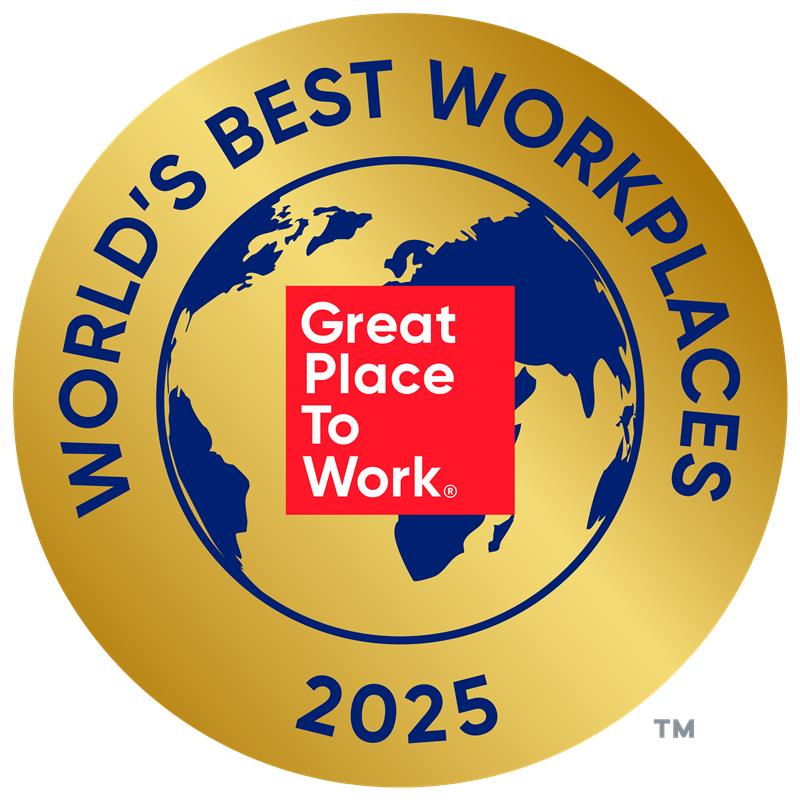
At Experian, we often say our people are our biggest superpower – and today, I’m thrilled to share that this belief has been recognised once again. Experian has been named one of the 2025 World’s Best Workplaces™ by Fortune and Great Place to Work® for the second year in a row.
This achievement reflects the culture we’ve built together – one that’s welcoming, inclusive, and rooted belonging. It’s a celebration of every colleague who brings their whole self to work, who lifts others up, and who powers opportunities for our clients, consumers, and communities.

We’ve made it our mission to create a workplace where everyone feels included, respected, and empowered. That’s why we’re proud to have earned top scores on the Corporate Equality Index and the Disability Equality Index, and to be recognised with the Outie Award for Workplace Excellence and Belonging.
These recognitions matter. But what matters most is how our people experience life at Experian. Whether it’s collaborating, innovating, or growing through world-class development of products, services and contributing to our communities, our culture is designed to help everyone thrive.
We’ve also made bold commitments to career development. Initiatives like Global Careers Week, the AI-driven performance coach Nadia, and the NextGen Forum – a global leadership development programme for emerging talent from across our regions – give our people the resources to take charge of their growth and build a “One Experian” mindset.
Being named one of the World’s Best Workplaces is a moment to celebrate but also a reminder to keep aiming higher. The world of work is evolving fast, and so are we. From embracing AI to enhancing our digital workplace experience, we’ll continue to push forward and listen to our people every step of the way.
Questions we will discuss:
- What does “retirement readiness” mean to you, and how can someone tell when they are financially ready to retire?
- Is there a magic number for retirement savings, and what factors should someone consider when setting a retirement goal?
- How can someone estimate their retirement expenses realistically?
- What are some common myths or misconceptions about how much money you need to retire?
- How should Gen Z, Millennials, and Gen Xers each approach retirement planning differently based on their stage of life?
- What are the biggest obstacles people face when trying to save for retirement, and how can they overcome them?
- How can you balance saving for retirement with paying off debt or supporting family today?
- What tools, calculators, or strategies can help people figure out if they’re on track for retirement?
- How can people prepare for unexpected costs or life changes that could impact their retirement plans?
- What’s one piece of advice you’d give someone just starting—or restarting—their retirement savings journey?
| Columns 1 | Column 2 | Column 3 | Column 4 |
|---|---|---|---|
| Row 1 Col 1 | |||
| Row 2 Col 1 | |||
| Row 3 Col 1 | |||
| Footer 1 | Footer 2 | Footer 3 | Footer 4 |

Credit Chat
Stretching your Dollars: Practical Tips to Cut Costs and Save More
February 5, 2025 3-4 PM ET
- What does “retirement readiness” mean to you, and how can someone tell when they are financially ready to retire?
- Is there a magic number for retirement savings, and what factors should someone consider when setting a retirement goal?
- How can someone estimate their retirement expenses realistically?

Greater transparency in buy now, pay later activity is key to helping consumers build their credit histories and supporting responsible lending. We have members of the military right now right out of high school and there’s not a lot of experience managing their own money. They’re quickly thrust into a place where they don’t have a support system to do that. We have members of the military right now right out of high school and there’s not a lot of experience managing their own money. They’re quickly thrust into a place where they don’t have a support system to do that. We have members of the military right now right out of high school and there’s not a lot of experience managing their own money. They’re quickly thrust into a place where they don’t have a support system to do that. We have members of the military right now right out of high school and there’s not a lot of experience managing their own money. They’re quickly thrust into a place where they don’t have a support system to do that. We have members of the military right now right out of high school and there’s not a lot of experience managing their own money. They’re quickly thrust into a place where they don’t have a support system to do that.
Experian North AmericaScott Brown, Group President, Financial Services

Further evidence of economic recovery throughout the nation, an Experian trends analysis of new mortgages and bankcards from Q1 2013 showed a 16 percent year-over-year increase in mortgage origination volume and a 20 percent increase in bankcard limits. Other insights offered by Experian, include evidence of a strong rebound in the Midwest as well as unprecedented lows in bankcard delinquencies. Mortgage trends Mortgage origination volume saw a 16 percent increase over the same quarter a year ago. This upward trend in volumes over the past eight quarters points to a consistently improving housing market. Average home prices increased slightly from 2011. California continues to lead the way, with an average home price of $325,000. The South Central region increased to $169,000, surpassing the Midwest, which came in at $163,000. However, regional share of originated mortgage dollars showed strong activity in the Midwest as the new year began, with the Midwest rebounding by growing 27 percent year over year to $101 billion. For the first time in two years, the region surpassed California, which grew by 6 percent to $92 billion. Mortgage delinquency rates also continued to improve, reaching multiyear lows. There was a slight increase in late-stage 90- to 180-day delinquency that may be the result of continued stress in some specific housing markets. Bankcard trends Bankcard lending continues to slowly build every quarter, reaching a 20 percent year-over-year increase in total origination volume limits extended into the market during Q1 2013, which is up about $11 billion. According to the analysis Experian is seeing increased bankcard lending taking place in the prime and super-prime space. Significant year-over-year growth rates occurred within the near-prime segment, which saw a 42 percent increase, while the prime space grew 30 percent. Bankcard performance is also near record lows for each of the delinquency periods. Experian saw a slight seasonal uptick in charge-offs from 3.9 percent to 4.3 percent, but other than that, it was another very strong quarter for payment performance. The 30 to 59 days past due (DPD) went to 0.94 percent — six basis points lower than the previous quarter. Also, the 60 to 89 DPD went to 0.59 percent from 0.65 percent, and the 90 to 180 DPD was flat at 1.56 percent. In looking at the 30-plus-day delinquency rate by state for the quarter, Experian saw North Dakota lead the best-performing states, with the lowest rate of 1.94 percent. This was followed by Alaska at 2.23 percent, Wyoming at 2.34 percent, South Dakota at 2.41 percent and Iowa at 2.42 percent. The states that did not perform well for the quarter were Nevada at 3.81 percent, Arizona at 3.79 percent, Florida at 3.71 percent, Mississippi at 3.51 percent and Alabama at 3.40 percent. This information shows that the spread between the highest- and lowest-performing states for bankcards is continuing to close. The data for this insight and analysis was provided by Experian’s IntelliViewSM product. IntelliView data is sourced from the information that supports the Experian–Oliver Wyman Market Intelligence Reports and is easily accessed through an intuitive, online graphical user interface, which enables financial professionals to extract key findings from the data and integrate them into their business strategies. This unique data asset does this by delivering market intelligence on consumer credit behavior within specific lending categories and geographic regions.

Experian has provided World Omni Financial Corp. (World Omni) with a flexible decision management solution based on its PowerCurve™ and Attribute Toolbox™ software that will streamline the processing and decisioning of automotive finance applications. “We needed a decision management solution, and Experian could deliver cost-effective, robust technology that quickly and seamlessly integrated with our loan origination system. This tool will enable us to grow our automotive finance business,” said Bill Shope, vice president of Portfolio Management at World Omni Financial Corp. “The solution also needed to be flexible enough to provide us with long-term support and growth capabilities as customer needs and market dynamics change.” As part of the solution, Experian’s PowerCurve Strategy Management software will enable World Omni to quickly design, test, execute and continuously improve decision strategies. Experian’s Attribute Toolbox will allow World Omni to tap into the wealth of credit and noncredit data available in today’s market. It also contains Experian’s Premier Attributes, the credit industry’s most robust and predictive tri-bureau credit attributes, and Custom Attributes, which enable users to make risk decisions within their application processing system that are specific to their financing processes. “Organizations like World Omni are constantly trying to better understand consumers, analyze areas for risk and look for new growth opportunities,” said Charles Chung, president of Decision Analytics North America at Experian. “This requires empowering business users, without overburdening IT, to make and monitor decisions that result in both loyal customers and improved profits. To accomplish this, they need the power of today’s best decision management software and the intelligence of advanced analytics that will provide them with more agility, flexibility, control and insight into every lending decision.” Experian provides software, analytics and services in a number of ways to meet individual client needs. The World Omni solution has been implemented in a secure, hosted environment within the Experian firewall at one of its state-of-the-art data centers. World Omni also will utilize Experian’s Precise IDSM product for verification and fraud detection. These services are integrated with Experian’s PowerCurve Strategy Management and Attribute Toolbox.

Most people shopping for a new car ask themselves that question all the time. In fact, there are many questions that surround whether to buy or lease a vehicle. What are the benefits of one over the other? Would my payment be lower if I leased? What if I decided to buy the car after, would there be a penalty? Recently, these questions became very real to me when I found myself having to shop for a new car following the untimely death of my husband’s previous vehicle. The deceased was the typical “Dude” car – huge engine, power everything and it was bright yellow. For the new car, I wanted him to get something a bit more sensible; He wanted everything he had before and then some. So, as you can imagine, shopping was a lot of fun (insert sarcasm here). I am glad to say, however, that what we ended up with made us both very happy and satisfied. We ultimately agreed upon a brand new dark gray metallic mid-sized sedan with lots of nice features to please the gadget fanatic in my husband, and a fuel efficient engine to please the economical budgetista in me. And for the first time in our adult lives, we leased! As it turns out, Experian Automotive’s recently released State of the Automotive Finance Market report showed that lots of folks are making that same decision. In fact, this quarter’s report said that automotive leasing achieved the highest level since the organization began tracking the data in 2006. According to the report, leasing accounted for a record 27.5 percent of all new vehicles financed, up from 24.4 percent in Q1 2012. Additionally, findings showed that the average monthly payment for a new vehicle financed in Q1 was $459, down from $462 in Q1 2012. While leasing a vehicle can help consumers achieve a lower monthly payment, the report also showed a rise in loan term lengths (65 months in Q1 2013, up from 64 months in Q1 2012) and a decrease in interest rates (4.5 percent in Q1 2013, down from 4.6 percent in Q1 2012), which helped to keep payments low for new vehicles financed. In Q1, the average loan amount for a new vehicle financed increased by $628, going from $26,020 in Q1 2012, to $26,648 in Q1 2013. The average used vehicle loan increased $461, going from $17,071 in Q1 2012, to $17,532 in Q1 2013. Check out the full press release. For more information on this report and other automotive-related insights, please visit www.Experian.com/Automotive.
2024 Best Place to Work for Disability Inclusion


